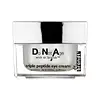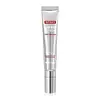What's inside
What's inside
 Key Ingredients
Key Ingredients

 Benefits
Benefits

 Concerns
Concerns

 Ingredients Side-by-side
Ingredients Side-by-side

Water
Skin ConditioningButyrospermum Parkii Butter
Skin ConditioningCetyl Palmitate
EmollientCyclopentasiloxane
EmollientMethylsilanol Hydroxyproline Aspartate
Skin ConditioningSiloxanetriol Alginate
Skin ConditioningC12-16 Alcohols
EmollientGlycerin
HumectantCetyl Alcohol
EmollientCetyl Lactate
EmollientOctyldodecyl Stearate
EmollientGlyceryl Stearate Citrate
EmollientBis-Hydroxyethoxypropyl Dimethicone
EmollientButylene Glycol
HumectantDimethicone
EmollientPalmitic Acid
EmollientSimmondsia Chinensis Seed Oil
EmollientCitrus Limon Fruit Extract
MaskingLavandula Angustifolia Oil
MaskingRetinyl Palmitate
Skin ConditioningCamellia Sinensis Leaf Extract
AntimicrobialVitis Vinifera Fruit Extract
Skin ConditioningCeramide NP
Skin ConditioningTocopheryl Acetate
AntioxidantCamellia Oleifera Leaf Extract
AstringentSodium Acrylates Copolymer
Hydrogenated Polyisobutene
EmollientPhospholipids
Skin ConditioningPolyglyceryl-10 Stearate
Skin ConditioningHelianthus Annuus Seed Oil
EmollientPhenoxyethanol
PreservativeEthylhexylglycerin
Skin ConditioningCaffeine
Skin ConditioningLecithin
EmollientAcetyl Hexapeptide-8
HumectantGlyceryl Polymethacrylate
Propylene Glycol
HumectantPalmitoyl Tripeptide-1
Skin ConditioningAlcohol Denat.
AntimicrobialPolyglyceryl-3 Stearate
EmulsifyingSodium Hydroxide
BufferingDisodium EDTA
Xanthan Gum
EmulsifyingBHT
AntioxidantSodium PCA
HumectantAcetyl Citrull Amido Arginine
Skin ProtectingBetaine
HumectantPotassium Sorbate
PreservativeWater, Butyrospermum Parkii Butter, Cetyl Palmitate, Cyclopentasiloxane, Methylsilanol Hydroxyproline Aspartate, Siloxanetriol Alginate, C12-16 Alcohols, Glycerin, Cetyl Alcohol, Cetyl Lactate, Octyldodecyl Stearate, Glyceryl Stearate Citrate, Bis-Hydroxyethoxypropyl Dimethicone, Butylene Glycol, Dimethicone, Palmitic Acid, Simmondsia Chinensis Seed Oil, Citrus Limon Fruit Extract, Lavandula Angustifolia Oil, Retinyl Palmitate, Camellia Sinensis Leaf Extract, Vitis Vinifera Fruit Extract, Ceramide NP, Tocopheryl Acetate, Camellia Oleifera Leaf Extract, Sodium Acrylates Copolymer, Hydrogenated Polyisobutene, Phospholipids, Polyglyceryl-10 Stearate, Helianthus Annuus Seed Oil, Phenoxyethanol, Ethylhexylglycerin, Caffeine, Lecithin, Acetyl Hexapeptide-8, Glyceryl Polymethacrylate, Propylene Glycol, Palmitoyl Tripeptide-1, Alcohol Denat., Polyglyceryl-3 Stearate, Sodium Hydroxide, Disodium EDTA, Xanthan Gum, BHT, Sodium PCA, Acetyl Citrull Amido Arginine, Betaine, Potassium Sorbate
Water
Skin ConditioningCetyl Ethylhexanoate
EmollientSalvia Officinalis Extract
AntimicrobialGlycerin
HumectantNiacinamide
SmoothingDipropylene Glycol
HumectantPolyglyceryl-3 Methylglucose Distearate
EmulsifyingCyclohexasiloxane
EmollientCetearyl Alcohol
EmollientStearic Acid
Cleansing1,2-Hexanediol
Skin ConditioningOlea Europaea Fruit Oil
MaskingButyrospermum Parkii Butter
Skin ConditioningPanthenol
Skin ConditioningTremella Fuciformis Extract
HumectantPimpinella Anisum Seed Extract
AstringentSalmon Egg Extract
Butylene Glycol
HumectantJuniperus Oxycedrus Wood Extract
PerfumingCarnosine
Skin ConditioningHydrolyzed Soy Protein
HumectantAcetyl Hexapeptide-8
HumectantCopper Tripeptide-1
Skin ConditioningPalmitoyl Pentapeptide-4
Skin ConditioningTripeptide-1
Skin ConditioningPalmitoyl Tripeptide-1
Skin ConditioningHexapeptide-9
Skin ConditioningNonapeptide-1
Skin ConditioningPalmitoyl Tetrapeptide-7
Skin ConditioningPalmitoyl Tripeptide-5
Skin ConditioningRosa Rugosa Callus Culture Extract
AntimicrobialCamellia Sinensis Leaf Extract
AntimicrobialCentella Asiatica Extract
CleansingGlycyrrhiza Glabra Root Extract
BleachingGold
Cosmetic ColorantRosa Canina Fruit Extract
AstringentChamomilla Recutita Extract
Skin ConditioningRosmarinus Officinalis Leaf Extract
AntimicrobialLactobacillus
Skin ConditioningSalix Alba Bark Extract
AstringentCinnamomum Cassia Extract
Skin ConditioningOriganum Vulgare Leaf Extract
Skin ConditioningPinus Pinaster Leaf Extract
Skin ConditioningPortulaca Oleracea Extract
Skin ConditioningHydrogenated Polyisobutene
EmollientUlmus Davidiana Root Extract
Skin ConditioningHydroxypropyltrimonium Hyaluronate
Sodium Acetylated Hyaluronate
HumectantHydrolyzed Hyaluronic Acid
HumectantHyaluronic Acid
HumectantSodium Hyaluronate Crosspolymer
HumectantHydrolyzed Sodium Hyaluronate
Skin ConditioningPotassium Hyaluronate
Skin ConditioningHydrolyzed Collagen
EmollientRoyal Jelly Extract
Skin ConditioningArgania Spinosa Kernel Oil
EmollientSqualane
EmollientCeramide NP
Skin ConditioningTocopheryl Acetate
AntioxidantAdenosine
Skin ConditioningDisodium EDTA
Betaine
HumectantSodium Hyaluronate
HumectantCarbomer
Emulsion StabilisingEthylhexylglycerin
Skin ConditioningGlyceryl Stearate
EmollientTromethamine
BufferingSodium Polyacrylate
AbsorbentEthylhexyl Stearate
EmollientTrideceth-6
EmulsifyingPentylene Glycol
Skin ConditioningCaprylyl Glycol
EmollientHydroxyacetophenone
AntioxidantDipotassium Glycyrrhizate
HumectantParfum
MaskingWater, Cetyl Ethylhexanoate, Salvia Officinalis Extract, Glycerin, Niacinamide, Dipropylene Glycol, Polyglyceryl-3 Methylglucose Distearate, Cyclohexasiloxane, Cetearyl Alcohol, Stearic Acid, 1,2-Hexanediol, Olea Europaea Fruit Oil, Butyrospermum Parkii Butter, Panthenol, Tremella Fuciformis Extract, Pimpinella Anisum Seed Extract, Salmon Egg Extract, Butylene Glycol, Juniperus Oxycedrus Wood Extract, Carnosine, Hydrolyzed Soy Protein, Acetyl Hexapeptide-8, Copper Tripeptide-1, Palmitoyl Pentapeptide-4, Tripeptide-1, Palmitoyl Tripeptide-1, Hexapeptide-9, Nonapeptide-1, Palmitoyl Tetrapeptide-7, Palmitoyl Tripeptide-5, Rosa Rugosa Callus Culture Extract, Camellia Sinensis Leaf Extract, Centella Asiatica Extract, Glycyrrhiza Glabra Root Extract, Gold, Rosa Canina Fruit Extract, Chamomilla Recutita Extract, Rosmarinus Officinalis Leaf Extract, Lactobacillus, Salix Alba Bark Extract, Cinnamomum Cassia Extract, Origanum Vulgare Leaf Extract, Pinus Pinaster Leaf Extract, Portulaca Oleracea Extract, Hydrogenated Polyisobutene, Ulmus Davidiana Root Extract, Hydroxypropyltrimonium Hyaluronate, Sodium Acetylated Hyaluronate, Hydrolyzed Hyaluronic Acid, Hyaluronic Acid, Sodium Hyaluronate Crosspolymer, Hydrolyzed Sodium Hyaluronate, Potassium Hyaluronate, Hydrolyzed Collagen, Royal Jelly Extract, Argania Spinosa Kernel Oil, Squalane, Ceramide NP, Tocopheryl Acetate, Adenosine, Disodium EDTA, Betaine, Sodium Hyaluronate, Carbomer, Ethylhexylglycerin, Glyceryl Stearate, Tromethamine, Sodium Polyacrylate, Ethylhexyl Stearate, Trideceth-6, Pentylene Glycol, Caprylyl Glycol, Hydroxyacetophenone, Dipotassium Glycyrrhizate, Parfum
Ingredients Explained
These ingredients are found in both products.
Ingredients higher up in an ingredient list are typically present in a larger amount.
Acetyl Hexapeptide-8, commonly known as Argireline or Acetyl Hexapeptide-3, is a popular peptide in skincare. It’s often referred to as a “Botox-like” ingredient because it helps reduce muscle movement.
By relaxing these micro-movements, Argireline may help minimize the appearance of fine lines and wrinkles. That said, it’s not as powerful as Botox, and research on its long-term effectiveness is still limited.
Beyond smoothing, Argireline may also support collagen production. Collagen is the protein that helps keep your skin firm, bouncy, and well-hydrated by strengthening the skin barrier.
So while Argireline isn’t a miracle fix, it can be a helpful addition to a routine focused on both prevention and skin health.
Read more about other common types of peptides here:
Learn more about Acetyl Hexapeptide-8Betaine is a common humectant (a substance that promotes retention of moisture). It's known to be gentle on the skin and can help balance hydration.
This ingredient is best for improving hydration and soothing irritated skin. Studies also show it helps even out skin tone.
Fun fact: Betaine is naturally created in the skin and body. The kind found within cosmetic products can be either plant-derived or synthetic.
Another name for betaine is trimethylglycine.
Learn more about BetaineButylene Glycol (or BG) is used within cosmetic products for a few different reasons:
Overall, Butylene Glycol is a safe and well-rounded ingredient that works well with other ingredients.
Though this ingredient works well with most skin types, some people with sensitive skin may experience a reaction such as allergic rashes, closed comedones, or itchiness.
Learn more about Butylene GlycolThis ingredient is also known as shea butter. It is an effective skin hydrator and emollient.
Emollients help soothe and soften your skin. It does this by creating a protective film on your skin. This barrier helps trap moisture and keeps your skin hydrated. Emollients may be effective at treating dry or itchy skin.
Shea butter is rich in antioxidants. Antioxidants help fight free-radicals, or molecules that may harm the body. It is also full of fatty acids including stearic acid and linoleic acid. These acids help replenish the skin and keep skin moisturized.
While Shea Butter has an SPF rating of about 3-4, it is not a sunscreen replacement.
Shea butter may not be fungal acne safe. We recommend speaking with a professional if you have any concerns.
Learn more about Butyrospermum Parkii ButterCamellia Sinensis Leaf Extract is derived from the leaves of the tea plant. Black tea, green tea, and oolong tea are all harvested from this plant.
This ingredient has many skin benefits:
This ingredient contains polyphenols, a strong antioxidant. Antioxidants help fight off molecules that damage skin cells.
On top of that, the antioxidants in green tea neutralize free-radicals from the sun. This gives the skin some extra UV protection, but should not replace sunscreen.
Many components of tea have anti-inflammatory properties.
Polyphenols and L-theanine help soothe the skin and reduce irritation. The caffeine in Camellia Sinensis Leaf Extract helps calm inflamed blood vessels.
Other compounds found in tea include: Vitamin Bs, linoleic acid, magnesium, calcium, iron, and zinc.
Research has shown both drinking Camellia Sinensis Leaf Tea and applying it to the skin can help boost skin elasticity and hydration. Studies also show using tea extract may reduce sebum, or oil, production.
Learn more about Camellia Sinensis Leaf ExtractCeramide NP is a type of ceramide and formally known as ceramide 3.
Ceramides are intercellular lipids naturally found in our skin that bonds dead skin cells together to create a barrier. They are known for their ability to hold water and thus are a great ingredient for dry skin.
Ceramides are an important building block for our skin barrier. A stronger barrier helps the skin look more firm and hydrated. By bolstering the skin ceramides act as a barrier against irritating ingredients. This can help with inflammation as well.
If you would like to eat ceramides, sweet potatoes contain a small amount.
Read more about other common types of ceramides here:
Ceramide AP
Ceramide EOP
Disodium EDTA plays a role in making products more stable by aiding other preservatives.
It is a chelating agent, meaning it neutralizes metal ions that may be found in a product.
Disodium EDTA is a salt of edetic acid and is found to be safe in cosmetic ingredients.
Learn more about Disodium EDTAEthylhexylglycerin (we can't pronounce this either) is commonly used as a preservative and skin softener. It is derived from glyceryl.
You might see Ethylhexylglycerin often paired with other preservatives such as phenoxyethanol. Ethylhexylglycerin has been found to increase the effectiveness of these other preservatives.
Glycerin is already naturally found in your skin. It helps moisturize and protect your skin.
A study from 2016 found glycerin to be more effective as a humectant than AHAs and hyaluronic acid.
As a humectant, it helps the skin stay hydrated by pulling moisture to your skin. The low molecular weight of glycerin allows it to pull moisture into the deeper layers of your skin.
Hydrated skin improves your skin barrier; Your skin barrier helps protect against irritants and bacteria.
Glycerin has also been found to have antimicrobial and antiviral properties. Due to these properties, glycerin is often used in wound and burn treatments.
In cosmetics, glycerin is usually derived from plants such as soybean or palm. However, it can also be sourced from animals, such as tallow or animal fat.
This ingredient is organic, colorless, odorless, and non-toxic.
Glycerin is the name for this ingredient in American English. British English uses Glycerol/Glycerine.
Learn more about GlycerinHydrogenated Polyisobutene is a synthetic polymer. Polymers are compounds with high molecular weight. Hydrogenated Polyisobutene is an emollient and texture enhancer.
In one study, Hydrogenated Polyisobutene showed better skin hydration levels than Caprylic/Capric Triglyceride. As an emollient, it helps keep your skin soft and hydrated by trapping moisture in.
Hydrogenated Polyisobutene is often used as a mineral oil replacement.
Learn more about Hydrogenated PolyisobutenePalmitoyl Tripeptide-1 is also known as pal-GHK. It is made up of 3 amino acids and palmitic acid, a fatty acid that helps it absorb into skin more easily.
This peptide is as a signal peptide, meaning it tells the skin to produce more collagen. Collagen is the key protein that helps form the skin's structure and keep it plump, firm, and hydrated.
By boosting collagen production, this ingredient supports a stronger skin barrier and helps reduce the appearance of wrinkles.
You'll most likely see this ingredient paired with Palmitoyl Tetrapeptide-7 in the well-known Matrixyl 3000 complex. While results from in-house testing should be viewed cautiously, this peptide duo is among the most studied and widely used in modern skincare.
Due to its palmitic acid base, this ingredient may not be safe for Malassezia folliculitis.
Read more about other common types of peptides here:
Learn more about Palmitoyl Tripeptide-1Tocopheryl Acetate is AKA Vitamin E. It is an antioxidant and protects your skin from free radicals. Free radicals damage the skin by breaking down collagen.
One study found using Tocopheryl Acetate with Vitamin C decreased the number of sunburned cells.
Tocopheryl Acetate is commonly found in both skincare and dietary supplements.
Learn more about Tocopheryl AcetateWater. It's the most common cosmetic ingredient of all. You'll usually see it at the top of ingredient lists, meaning that it makes up the largest part of the product.
So why is it so popular? Water most often acts as a solvent - this means that it helps dissolve other ingredients into the formulation.
You'll also recognize water as that liquid we all need to stay alive. If you see this, drink a glass of water. Stay hydrated!
Learn more about Water